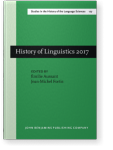The history of language learning and teaching (HoLLT) in the
history of linguistics
Fifty years after two of the first overviews of the
history of language teaching (Titone 1968, Kelly
1969), this paper highlights the value of the history of language learning and teaching (HoLLT) to the history of
linguistics, from three perspectives: (1) theoretical and descriptive
insights; (2) insights into practice (e.g. changing conceptions and
articulations of what it means to learn a language, reflecting
changing language ideologies); and (3) making space in the history of
linguistics for “history from below” – in particular as learning and
teaching of languages, offered a space for females’ participation in
and visibility in linguistic matters.
Article outline
- 1.Introduction
- 2.HoLLT and new descriptive and theoretical insights in the history
of linguistics
- 2.1The case of word order in German
- 2.2HoLLT and timelines for language change and language
description: The case of forms of address in German
- 3.Observing Changes in practice in HoLLT as evidence for changing
language conceptualizations and ideologies
- 4.History of linguistics ‘from below’, especially women in the
history of linguistics
- 4.Conclusion
-
Notes
-
References
